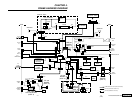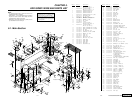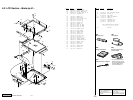
2-4PCG-Z505LE/Z505LEK/Z505LS/Z505LSK (UC)
Confidential
• IEEE 1394 Interface test...
Performs the 1394 communication test. Another personal computer to communicate with is necessary for this test. The
models released from the year 2000 have already been confirmed that they do not cause any problems regarding the
IEEE1394 interface. Even models released before 2000 will cause no problem if the same type of IEEE1394 interface IC
chip (the IC chip used in the iLink block connected to the PCI bus) is used in both personal computers that are connected.
In other combinations, the IEEE1394 interface test is not confirmed. (Use of the models released from the year 2000 is
recommended.)
1. Connect the iLink cable.
2. Start up the personal computer at the other end of the IEEE1394 interface test connection using the tool floppy disk
that must be created beforehand by copying programs from the service diagnostics CD disc. (Prepare a floppy disk
that is formatted to contain the DOS system. Create a tool floppy disk by copying the entire TOOL folder of the CD
disc to a floppy disk.)
3. Select the 1394 test from the menu at the connected computer to enter the reception state.
4. After the connected personal computer has entered the reception state, select the 1394 test at the personal computer
to be tested. The IEEE1394 interface test then starts. Send and receive of the random data are repeated five times
(i.e., this test is repeated five times.)
• IrDA test...
Performs the IrDA communication test. Another personal computer to communicate with is necessary for this test. The
models released from the year 2000 have already been confirmed that they do not cause any problems regarding the IrDA
communication. Even models released before 2000 will cause no problem if the same type of IrDA communication IC chip
(the IC chip used in the SIE block connected to the Extend I/O bus) is used in both personal computers that are connected.
In other combinations, the IrDA communication test is not confirmed. (Use of the models released from the year 2000 is
recommended.)
1. Place the two computers so that their IrDA transmitter and receiver ports face each other.
2. Start up the personal computer at the other end of the IrDA communication test connection using the tool floppy disk
that must be created beforehand by copying programs from the service diagnostics CD disc. (Prepare a floppy disk
that is formatted to contain the DOS system. Create a tool floppy disk by copying the entire TOOL folder of the CD
disc to a floppy disk.)
3. Select the IrDA communication test from the menu at the connected computer to enter the reception state.
4. After the connected personal computer has entered the reception state, select the IrDA communication test at the
personal computer to be tested. The IrDA communication test then starts.
• Jog dial test...
Tests the revolution and clicking of the jog dial. Angle brackets < > appear when the jog dial test is selected. Rotate the jog
dial clockwise (upwards) until it moves to the mark (^_^) then press the jog dial. The mark (^_^) appear will on the top of
the screen. Then rotate the jog dial counter-clockwise (downwards) until it moves to the mark (^_^) then press the jog dial.
• Short aging test.../Long aging test...
Performs the aging test. The short aging test ends when all test items have been performed once. The long aging test
checks the machine for about 10 hours by repeating the test items.
• Aging test including the HDD...
NOTE: Note that this test destroys the entire contents of the user’s hard disk drive.
Perform this test only when destructive testing of HDD is desired.
The aging test is performed first, then read and write tests of the hard disk are implemented following the aging test. There
are two tests; LONG and SHORT. Contents of the LONG aging test are the same as those the “Long aging test...” of the
previous test item. Contents of the SHORT aging test are the same of the “Short aging test...” too. The test starts immedi-
ately when the menu item is selected.
• Exit from Diagnostics MENU
Quits the service diagnostics program and the DOS prompt appears. If you exit the service diagnostics program by
mistake, start up the program again.


















